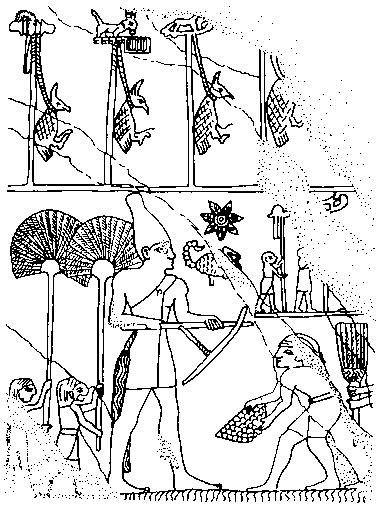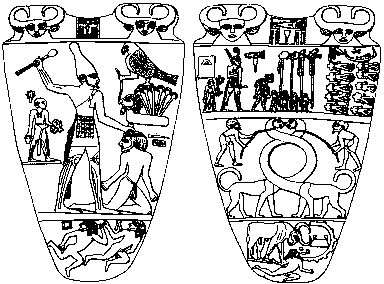Return to Contents.


| Escape to
student resources page,
transit lounge.
Return to Contents. |


|
The Late Naqada warlords fought among themselves, gradually conquering each other, until some conquering "general" made the final conquest that linked the whole of Upper and Lower Egypt. It is hard to be sure who the general was or how it was done. Manetho (who, of course, lived three thousand years later) tells us that the first ruler of united Egypt was named "Menes." Other authors speak of the unification of Egypt having taken place under a leader named Narmer, who may or may not have been the same person. Archaeological finds of the past two centuries have tended to confirm early accounts, although not without some confusion.
Three "powerfacts" found in the Nekhen excavations of 1897-1898, each with incised or low-relief pictures, have been useful in focusing thought: They are the "Mace Head of Scorpion" the "Mace Head of Narmer" (both now in the Ashmolean Museum of Oxford University), and especially the "Palette of Narmer" (in the Cairo Museum). The design from the "Mace Head of Scorpion" is shown at the left.

The Mace Head of Scorpion. Scorpion is so called because the scorpion portrayed just in front of the human figure is thought to represent his name, although we do not know how it would have been pronounced.
 More important for our purposes are the implements depicted. He is shown wearing a high hat that in later times was the crown of Upper Egypt. He is carrying a plow, but is protected from the heat by fan-bearers, so he is apparently about to engage in ceremonial plowing. Small figures at eye-level in front of him seem to be carrying standards on poles, similar to those on the boats in Naqada II tombs of 300 years or more earlier. We don't know what might once have been carved on the other side of the mace head, which was not preserved. Some specialists are inclined to think it may have represented Scorpion doing the same thing while wearing the crown of Lower Egypt. This would make sense if he and Narmer were the same person. Others believe Scorpion may have been the conqueror of Upper Egypt alone, perhaps setting things up for the unification by his successor, Narmer.
More important for our purposes are the implements depicted. He is shown wearing a high hat that in later times was the crown of Upper Egypt. He is carrying a plow, but is protected from the heat by fan-bearers, so he is apparently about to engage in ceremonial plowing. Small figures at eye-level in front of him seem to be carrying standards on poles, similar to those on the boats in Naqada II tombs of 300 years or more earlier. We don't know what might once have been carved on the other side of the mace head, which was not preserved. Some specialists are inclined to think it may have represented Scorpion doing the same thing while wearing the crown of Lower Egypt. This would make sense if he and Narmer were the same person. Others believe Scorpion may have been the conqueror of Upper Egypt alone, perhaps setting things up for the unification by his successor, Narmer.

Narmer. Narmer himself is best known to us from the Palette of Narmer, shown here. Stone palettes were used in Egypt as small grinding surfaces for colored minerals or other coloring matter that could be mixed with water to make paint or with fat to make body ointments. The Palette of Narmer, however, is a ceremonial palette, much too large (and heavy) for real use, and with only a small space in the middle as a relic of the function that non-"powerfact" palettes were originally intended for.
 The important point is that on one side it portrays Narmer (by that name) wearing the crown of Upper Egypt, and on the other it shows him wearing the crown of Lower Egypt. As such, it constitutes our best evidence that Egypt had become one state unified under one powerful ruler. Once again there are bearers of emblems on poles. And there are representations of Narmer trampling conquered people and of enemies beheaded. There is no question that both conquest and unification are being celebrated. The little space representing the old grinding surface part of the palette is formed by the intersecting necks of two fabulous animals, whose interlinking we can easily interpret as the unification of the two lands.
The important point is that on one side it portrays Narmer (by that name) wearing the crown of Upper Egypt, and on the other it shows him wearing the crown of Lower Egypt. As such, it constitutes our best evidence that Egypt had become one state unified under one powerful ruler. Once again there are bearers of emblems on poles. And there are representations of Narmer trampling conquered people and of enemies beheaded. There is no question that both conquest and unification are being celebrated. The little space representing the old grinding surface part of the palette is formed by the intersecting necks of two fabulous animals, whose interlinking we can easily interpret as the unification of the two lands.



